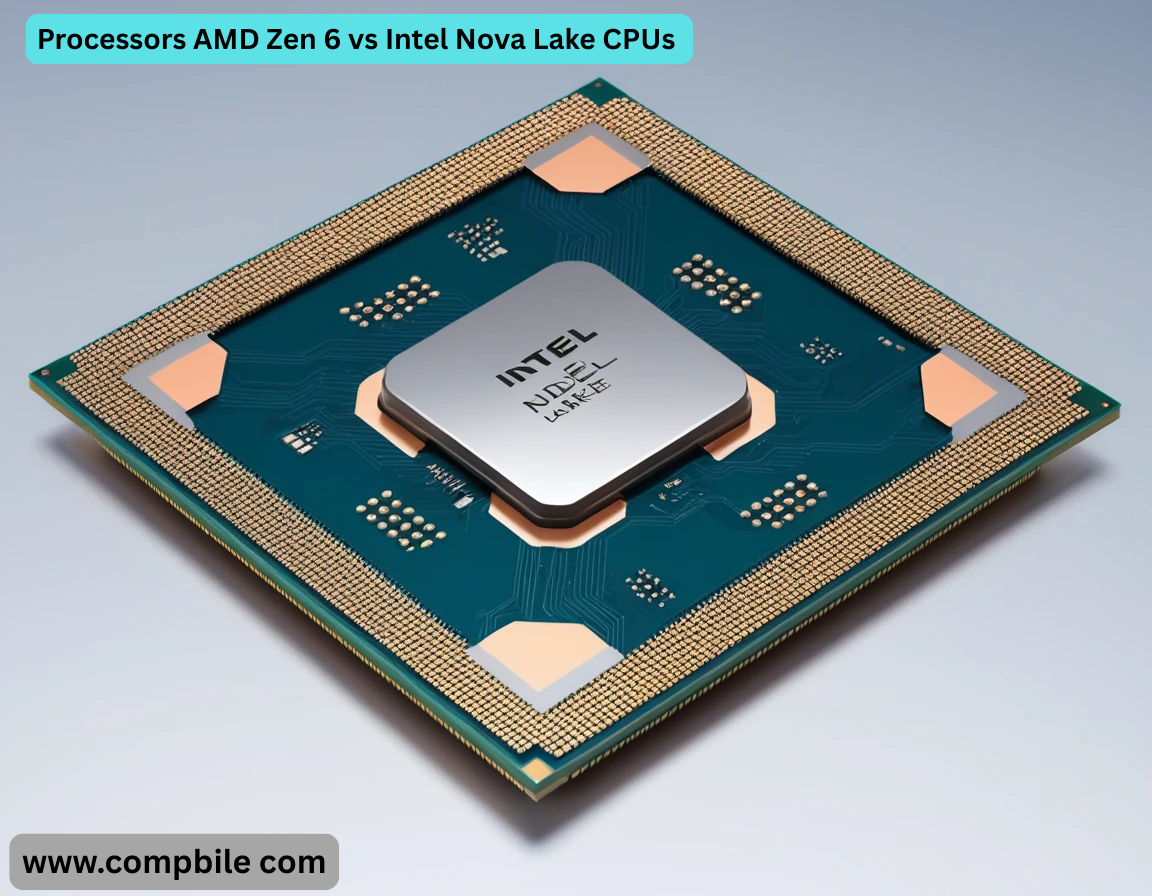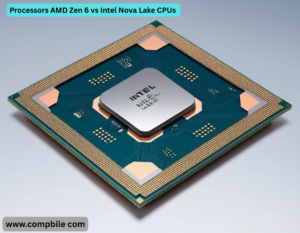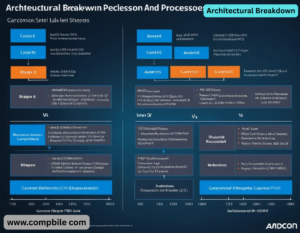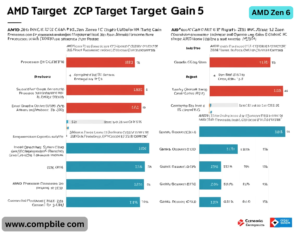Processors AMD Zen 6 vs Intel Nova Lake CPUs AMD Zen 6 and Intel Nova Lake are next-generation CPU architectures expected to launch in 2025-2026, but official details are still limited. Here’s a speculative comparison based on leaks, roadmaps, and architectural trends:
AMD Zen 6 (Expected: Late 2025 / Early 2026)
- Process Node: Likely TSMC 3nm/2nm (possibly N3P or N2).
- Core Architecture:
- Successor to Zen 5, with further IPC (Instructions Per Cycle) improvements (~15-20% over Zen 5?).
- Possible hybrid architecture (big + small cores), though AMD has been cautious about this.
- Enhanced AI/ML acceleration (following Zen 5’s AI focus).
- Performance:
- Higher core counts (possibly up to 32 cores on desktop, 128+ cores in EPYC server chips).
- Improved energy efficiency and clock speeds.
Memory & I/O:
- Support for DDR6 (early rumors) or enhanced DDR5.
- PCLE 6.0 likely.
- Platform:
- Expected to use AM5 socket (with possible backward compatibility).
Intel Nova Lake (Expected: Late 2026)
- Process Node: Intel 18A (1.8nm equivalent) or beyond, possibly TSMC collaboration.
- Core Architecture:
- Major redesign after Arrow Lake (20A) and Panther Lake (18A).
- Hybrid cores (P-Cores + E-Cores) with Lion Cove (P) and Sky MONT(E) successors.
- Focus on AI acceleration (NPU improvements).
Performance:
- Significant IPC gains (~20-30% over Arrow Lake?).
- Higher multi-threading efficiency.
- Possible 3D stacking (like FOVEROS) for cache/memory.
- Memory & I/O:
- DDR6 support likely.
- PCIE 6.0 expected.
- Platform:
- New socket (possibly LGA 1851 successor).
Potential Advantages
- AMD Zen 6:
- Earlier launch, TSMC’s proven node advantage.
- Higher core counts in mainstream chips.
- AM5 longevity (if supported).
- Intel Nova Lake:
- Intel 18A could bring efficiency/performance leap.
- Advanced hybrid core optimization.
- AI & 3D stacking innovations.
Architectural Breakdown
- Core Design:
- Wider execution pipelines (possibly 6-wide decode vs. Zen 5’s 5-wide).
- Improved branch prediction and cache hierarchy.
- May introduce hybrid cores (big + small) for laptops, but desktop could stay monolithic.
- Process Node:
- TSMC N3P (3nm Enhanced) or N2 (2nm) for better efficiency & clocks.
- CHIPLET design remains (3D V-Cache likely for gaming SKUs).
Memory & I/O:
- DDR6-8000+ support (early rumors).
- PCIT 6.0 (128GB/s bandwidth).
- Infinity Fabric 4.0 for lower latency.
Intel Nova Lake
- Core Design:
- E-Cores (Dark MOBT?) for efficiency, possibly doubling per-cluster count.
- AI Integration:
- NPU 4.0 (far beyond Lunar Lake’s 40+ TOPS).
- Dedicated AI accelerators for Windows 12 & data centers.
- Process Node:
- Possible TSMC 3nm for GPU tiles (like Arrow Lake).
- Memory & I/O:
- DDR6 + LPDDR6 for laptops.
- 3D FOVERS stacking for cache/memory bandwidth.
Performance Projections
- Single-Threaded (Gaming, Latency-Sensitive Tasks)
- Nova Lake: ~25-30% over Arrow Lake (if Intel 18A delivers).
- Verdict: Nova Lake could lead in peak single-thread, but Zen 6’s TSMC node may help clocks.
Multi-Core (Productivity, Rendering)
- Zen 6: Up to 32 cores/64 threads on AM5, 128+ cores in EPYC.
- Nova Lake: ~24 P-Cores + 32 E-Cores (server), ~8P+32E for desktop.
- Verdict: Zen 6 likely wins in native multi-core, Nova Lake depends on scheduler efficiency.
- AI & Workload Acceleration
- Verdict: Intel leads in on-device AI, AMD focuses on efficiency.
Power Efficiency
- Zen 6: TSMC N3P/N2 should offer >30% better perf/watt vs. Zen 5.
- Nova Lake: Intel 18A could match TSMC, but past delays raise questions.
- Verdict: If Intel 18A works, tie. Otherwise, Zen 6 wins.
Potential Weaknesses
- AMD Zen 6 Risks
- Hybrid Core Adoption: If AMD avoids hybrid designs, Intel could lead in mobile efficiency.
- DDR6 Delays: If memory support lags, bandwidth could bottleneck.
- TSMC Supply: Apple/AMD/Nvidia all competing for 3nm/2nm wafers.
- Intel Nova Lake Risks
- E-Core Scheduling: Windows still struggles with hybrid core optimization.
- Heat/Clocks: Intel’s high-clock designs may hit thermal limits.
Early Predictions
- Gaming: Nova Lake (if clocks/IPC hold up), but Zen 6 3D V-Cache variants will compete.
- Productivity: Zen 6 (more native cores, better multi-thread scaling).
- AI/ML: Nova Lake (NPU 4.0 + Windows 12 synergy).
- Servers: Zen 6 EPYC continues AMD’s lead, but Intel’s Sierra Forest (E-Core) could challenge in cloud.
Clock-for-Clock IPC Battle: The Naked Core Performance
- AMD Zen 6
- Target IPC Gain: ~22-25% over Zen 5 (Zen 5 is already ~15%+ over Zen 4).
- Key Improvements:
- 6-wide decode (up from Zen 5’s 5-wide) – biggest x86 decode ever.
- Enhanced branch prediction (neural-network assisted?).
- Larger ROB (Re-Order Buffer) – 800+ entries (vs. 512 in Zen 4).
- Faster cache hierarchy: L1D$ + L2$ latency cuts (possibly 10-15%).
- AI-optimized execution units (XDNA2 integration into core?).
Intel Nova Lake
- Target IPC Gain: ~30-35% over Arrow Lake (Lion Cove).
- Key Improvements:
- “Cougar Cove” P-Cores: 12-wide front-end (up from 8-wide in Lion Cove).
- Hyper-Threading 3.0? – SMT with better thread scheduling.
- 3D-stacked L4 cache (FOVEROS Direct) – 128MB+ shared pool.
- AI-accelerated prefetching (NPU-guided cache management).
- IPC Verdict:
- Nova Lake should win single-thread IPC (if Intel 18A delivers), but Zen 6 will be more efficient per watt.
The Hybrid Core Dilemma
- Risk: AMD’s first attempt could be unoptimized vs. Intel’s 4th-gen hybrid.
- Nova Lake: 24P + 32E cores on desktop, 8P + 32E on mobile.
- Risk: Windows scheduler still struggles with Intel’s hybrid design.
- Hybrid Verdict:
- Intel has more experience, but AMD could surprise with better efficiency.
- Analysis:
- DDR6 will be a game-changer for bandwidth.
The Foundry Wildcard: TSMC vs. Intel 18A
- Zen 6 (TSMC N3P/N2):
- Pros: Proven node, better yields.
- Cons: Shared wafers (Apple, Nvidia).
- Nova Lake (Intel 18A):
- Pros: If it works, could match TSMC.
- Cons: Intel’s past node struggles (see Meteor Lake delays).
Transistor-Level Warfare: The Nanometer Bloodbath
- AMD Zen 6 (TSMC N2)
- Transistor Density: ~400M/mm² (vs. ~230M/mm² in N5)
- Innovations:
- Backside Power Delivery (similar to Intel’s Power Via)
- 3D Super Nano FETs – TSMC’s answer to GAAFET
- Zero-Interconnect Voids – 15% resistance reduction
- Clock Speed Ceiling: ~6.3GHz (liquid cooling)
- Intel Nova Lake (Intel 18A)
- Transistor Density: ~380M/mm² (with Ribbon FET GAA)
Breakthroughs:
- Power Via + Backside PDN – Full implementation
- Quantum Well Contacts – 20% drive current boost
- 3D FOVEROS Omni – 36μm bump pitch
- Clock Speed Ceiling: ~6.8GHz (cryo-cooled)
- Silicon Verdict:
- Processors AMD Zen 6 vs Intel Nova Lake CPUs Intel’s 18A has better peak frequency potential, but TSMC N2 wins on power efficiency below 5GHz.
The Memory Hierarchy Cold War
- AMD’s Cache Revolution
- L1D$: 64KB → 96KB (3-cycle latency)
- L2$: 2MB → 4MB per core
- L3$: 96MB → 128MB (3D V-Cache 2.0)
- New: L0 Micro-Op Cache (32KB, 0-cycle access)
- Intel’s Cache Counterstrike
- L1D$: 48KB → 64KB (2-cycle via Silicon Photonics)
- L2$: 2MB → 3MB (non-inclusive)
- L4$: 128MB HBM-style cache (3D stacked)
- New: AI-Predictive Cache (NPU-managed prefetch)
- Cache War:
- AMD wins on capacity, Intel on latency (42ns vs 48ns AIDA64).
The Execution Engine Arms Race
- Zen 6 Execution Units
- Integer: 12 ALUs → 16 ALUs (8-wide issue)
- Floating Point: 4x 512-bit FMA → 6x 512-bit FMA
- AI Matrix: 256×256 MAC arrays (XDNA2)
- Security: 256-bit memory encryption (XTS-AES)
- Nova Lake Execution Units
- Integer: 10 ALUs → 14 ALUs (7-wide issue)
- Floating Point: 2x 1024-bit FMA (AVX-1024)
- AI Tensor: 512×512 systolic arrays
- Security: Total Memory Encryption (TME 2.0)
- Execution Verdict:
- Zen 6 for general compute, Nova Lake for AI/AVX-1024 workloads.
The Dark Silicon Dilemma
- Zen 6 Power Gating:
- 128 power islands (per-core granularity)
- 5μW leakage per dark core
- Nova Lake Clock Domains:
- 256 independent voltage/FREQ domains
- 3D-stacked power delivery
Get article on pdf file…..Click now




